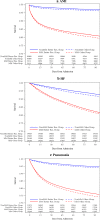Defining Multimorbidity in Older Patients Hospitalized with Medical Conditions
- PMID: 36385407
- PMCID: PMC10160274
- DOI: 10.1007/s11606-022-07897-4
Defining Multimorbidity in Older Patients Hospitalized with Medical Conditions
Abstract
Background: The term "multimorbidity" identifies high-risk, complex patients and is conventionally defined as ≥2 comorbidities. However, this labels almost all older patients as multimorbid, making this definition less useful for physicians, hospitals, and policymakers.
Objective: Develop new medical condition-specific multimorbidity definitions for patients admitted with acute myocardial infarction (AMI), heart failure (HF), and pneumonia patients. We developed three medical condition-specific multimorbidity definitions as the presence of single, double, or triple combinations of comorbidities - called Qualifying Comorbidity Sets (QCSs) - associated with at least doubling the risk of 30-day mortality for AMI and pneumonia, or one-and-a-half times for HF patients, compared to typical patients with these conditions.
Design: Cohort-based matching study PARTICIPANTS: One hundred percent Medicare Fee-for-Service beneficiaries with inpatient admissions between 2016 and 2019 for AMI, HF, and pneumonia.
Main measures: Thirty-day all-location mortality KEY RESULTS: We defined multimorbidity as the presence of ≥1 QCS. The new definitions labeled fewer patients as multimorbid with a much higher risk of death compared to the conventional definition (≥2 comorbidities). The proportions of patients labeled as multimorbid using the new definition versus the conventional definition were: for AMI 47% versus 87% (p value<0.0001), HF 53% versus 98% (p value<0.0001), and pneumonia 57% versus 91% (p value<0.0001). Thirty-day mortality was higher among patients with ≥1 QCS compared to ≥2 comorbidities: for AMI 15.0% versus 9.5% (p<0.0001), HF 9.9% versus 7.0% (p <0.0001), and pneumonia 18.4% versus 13.2% (p <0.0001).
Conclusion: The presence of ≥2 comorbidities identified almost all patients as multimorbid. In contrast, our new QCS-based definitions selected more specific combinations of comorbidities associated with substantial excess risk in older patients admitted for AMI, HF, and pneumonia. Thus, our new definitions offer a better approach to identifying multimorbid patients, allowing physicians, hospitals, and policymakers to more effectively use such information to consider focused interventions for these vulnerable patients.
Keywords: AMI; Medicare; heart failure; inpatient; multimorbidity; pneumonia.
© 2022. The Author(s), under exclusive licence to Society of General Internal Medicine.
Conflict of interest statement
The authors declare that they do not have a conflict of interest.
Figures
References
-
- Centers for Medicare & Medicaid Services. Chronic Conditions among Medicare Beneficiaries, Chartbook (2012) Edition. Available at: https://www.cms.gov/Research-Statistics-Data-and-Systems/Statistics-Tren.... .
Publication types
MeSH terms
Grants and funding
LinkOut - more resources
Full Text Sources
Medical
Research Materials
Miscellaneous


